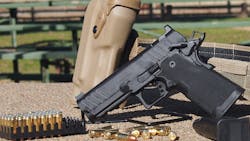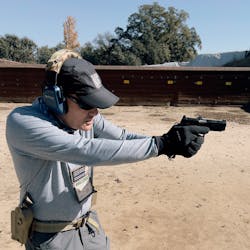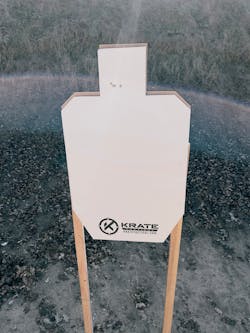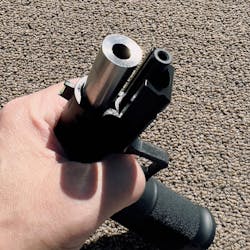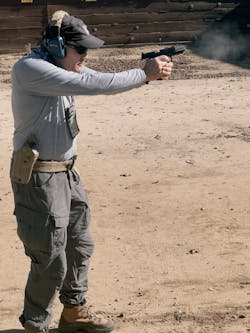Springfield 1911 DS Prodigy Review
I tested a Springfield 1911 DS Prodigy in 4.25”. It looks and operates like a traditional 1911, but is shoots like a race gun. If I was engaging multiple targets under significant pressure, I would use this gun.
The Prodigy has a hybrid frame, which consists of a forged steel upper, and a polymer grip section. Since this allows for a modular design, the Prodigy comes in a 17+1 and a 20+1 version. This design has the 1911 grip angle, and grip safety, combined with a modern feel and a double stack capacity.Using a forged upper portion mated to a polymer grip gives the user all kinds of advantages. First, we found that the slide reciprocates more like an expensive piece of furniture than a gun. This is because of two factors. The steel on steel fitting of the slide and upper gives it inherent smoothness. Second, polymer doesn’t transmit vibrations and torque like steel does, so much of the vibration and shock of the recoil is not sent to the user’s body. Third, the steel part has more mass than the rest of the gun, placing the most recoil resistant part in the part of the gun where it would do the most good.
Since the weight of the steel is just above the hand, it also serves as a dampening agent, in the same manner a tightrope walker sometimes uses a horizontal pole, or archery competitors use weighted rods extending from their bows. This increases the "moment of inertia," allowing a shooter to shoot more accurately when moving from target to target. The bull barrel sporting a target crown added to both the accuracy and the follow up shots.The inherent ability of the Prodigy to transition from target to target is easy to test using multiple targets. I found that, once the hammer falls, the recoil of the shot can “help” move the shooter to the next target. This is a training technique that competitive shooters use.
The Prodigy has a full-length rail, allowing for a full-size light attachment. There are dozens of lights that fit the Safariland 6354RDS holster, and the holster body will accommodate all sizes.
I have reviewed several Springfield products over the years, and every time I comment on the rigid, almost indestructible, magazines that fall freely from the guns. The Prodigy’s slick magazine inside the wide polymer body give it “race gun” smoothness in getting the gun back in the fight. Despite the capacity, Springfield has managed to keep a slim overall profile, making the Prodigy suitable for smaller hands. The 1911 DS magazines are also compatible with 2011 platform guns.Safariland ALS Holster
I set up a Safariland battle belt, complete with their ALS (6354RDS holster), their Model 4333 Low Profile Battle Belt, and Model 79 Slimline Open-Top Double Magazine Pouches.
The Safariland ALS System is one of the best holster systems on the market today. It uses an internal rotating device to clamp the gun in place, which locks the gun automatically when it is holstered. Calling this product a “holster” in it’s practical sense is actually incorrect, because it actually cradles the gun between its locking mechanism and the barrel. However, calling a hard-use holster a “cradle”-well, let’s stick with “holster”.
The Safariland ALS Holster System gives the officer a smooth, straight, draw. The locking device is quickly and instinctively overcome by the user’s natural draw motion, without increasing accessibility to any other party except the wearer. Some products have great engineering, but Safariland can also approach holster design with decades of feedback and experience. They have been around long enough to be my first duty holster purchase.
One thing that I tested about the 6354RDS holster was the fact that it had the same level of security, quietness, and draw with the Prodigy without a light or RDS. Nothing changed.
The ALS model I ordered came with dual, quick-release leg straps. There is also a single strap model. The holster body on this system gives the officer a lot of clearance for the Master Grip, and I found I could draw it consistently from the leg drop or the waistband. Since I was using the Low Profile Battle Belt as an instructor belt set up, I used Safariland’s MOLLE quick attachment kit to put the Prodigy on my waist.
Even without the extra belt padding, the Battle Belt is comfy, and the non-slip inner surface keeps the system stable. The whole set up is almost race ready, and even the open top magazine holders are like the ones I carried on duty. Set up like this, the Prodigy user can have a hundred rounds on the belt, if thats what they need.Rounds Downrange
I loaded up the Prodigy and set up a few IDPA style targets. I stepped back 7 yards, and rapid fired. I did the same at 10 yards. At 7 yards, almost all the bullet holes touched. The 10 yard target was tiny. Out of the box, this was one of the most intuitive guns I have shot all year.
I was shooting Magtech 115grain FMJ for testing, and these light bullets fed flawlessly in the 32.5 oz Prodigy.
The Prodigy has grip stippling that feels like the “cat’s tongue” scales of the original Gerber Mark II. This non slip texture allows the hands to mate with the surfaces of the grip, and stay there. The smooth section just under the trigger guard, coupled with the fine stippling of the mainspring housing gives precise tactile referencing to the shooter. These are dialed in features normally added as aftermarket in a competitive gun. For a duty gun, they could be a tactical edge.
The Prodigy has a standard slide release, and the ambidextrous safety is standard width. It may operate like a competition gun, but the controls suggest it was engineered for duty. I actually would have trimmed the safety even more, as I felt it was too close to the ALS holster release.
Between the gun and the holster, it was lightning fast, and I was able to draw and engage faster than my own setup. The Prodigy uses AOS (Agency Optics System) plates for officers who go with optics, and it can be purchased with a mounted Hex Dragonfly. The AOS allows officers to choose a compatible plate for their preferred optic. I liked the fiber optic iron sights on the one I tested, and having the AOS option gives the user flexibility. The Hex Dragonfly is an excellent optic, and, if I was going to start out with a mounted optic, this is the way to go.
Even at 20 yards, the Prodigy prints tight groups. The precision fitting of the components and a bull barrel with a competition crown are an easy explanations for the accuracy. However, the logical explanation is the superior design.Would we Swear in the Prodigy?
The Springfield 1911 DS Prodigy is one of the slickest shooting guns on the market right now, and it is high in the category of single action 1911 style handguns.
The single action design has several advantages, and one of them is a crisp consistent trigger. The Prodigy is one for real purists. For those who know 1911 style guns, it does not have a firing pin plunger, and therefore falls under the “Series 70” category. For those not "in the know," this means that it does not have the firing pin plunger safety mechanism, an assembly which purists (like me) believe affects the feel of the trigger and action. Don’t fret, the Prodigy still has three other safeties, which includes the one between the shooter’s ears.
The trigger is actually amazing, and the one thing it will do is improve qualification scores agency-wide. The Prodigy is safer, as it requires a manual safety, but it also requires an additional layer of training. Is this a good thing? Yes.
When I carried a 1911 on duty, I have held a gun on a suspect with the safety on dozens of times. Is it a worthwhile investment for an agency or an individual officer? Yes. The current trend of agency sales for this style of gun in Law Enforcement has demonstrated the efficacy of the platform itself.
About the Author
Lindsey Bertomen is a retired police officer and retired military small arms trainer. He teaches criminal justice at Hartnell College in Salinas, California. He has a BS in Criminal Justice and an MS in Online Teaching and Learning. Lindsey has taught shooting techniques for over a decade. He enjoys competing in shooting sports, running and cycling events.

Officer Lindsey Bertomen (ret.), Contributing Editor
Lindsey Bertomen is a retired police officer and retired military small arms trainer. He teaches criminal justice at Hartnell College in Salinas, California, where serves as a POST administrator and firearms instructor. He also teaches civilian firearms classes, enjoys fly fishing, martial arts, and mountain biking. His articles have appeared in print and online for over two decades.
